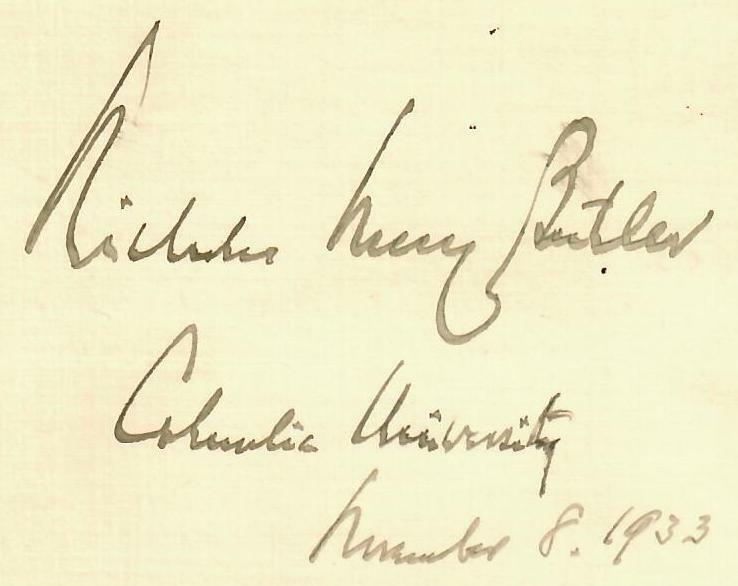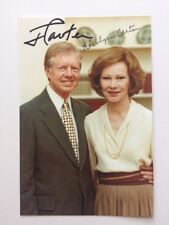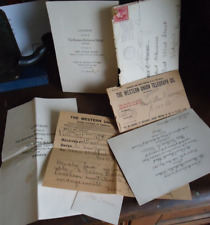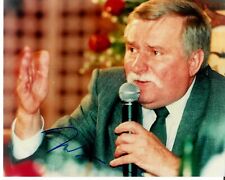\"Nobel Peace Prize\" Nicholas Murray Butler Signed 3X5 Card COA For Sale

When you click on links to various merchants on this site and make a purchase, this can result in this site earning a commission. Affiliate programs and affiliations include, but are not limited to, the eBay Partner Network.
\"Nobel Peace Prize\" Nicholas Murray Butler Signed 3X5 Card COA:
$104.99
ES-6618: Up for sale the \"Nobel Peace Prize\" recipient and President of Columbia University Nicholas Murray Butler Signed 3X5 Card. This item iscertified authentic by Todd Mueller and comes with their Certificate ofAuthenticity.ES-6618
NicholasMurray Butler(April 2, 1862 –December 7, 1947) was an American philosopher, diplomat, and educator. Butlerwas president ofColumbia University,president of theCarnegieEndowment for International Peace, a recipient of theNobel Peace Prize, and the deceasedJames S. Sherman\'s replacement asWilliam Howard Taft’srunning mate in the1912 UnitedStates presidential election. He became so well known and respectedthatThe New York Timesprintedhis Christmas greeting to the nation every year. Butler, great-grandsonofMorgan John Rhys, was born inElizabeth, New JerseytoMary Butler and manufacturing worker Henry Butler. He enrolled inColumbia College(laterColumbia University) and joined thePeithologian Society. Heearned his bachelor of arts degree in 1882, his master\'s degree in 1883 and hisdoctorate in 1884. Butler\'s academic and other achievements ledTheodore Roosevelttocall him \"Nicholas Miraculous.\" In 1885, Butler studied in Paris andBerlin and became a lifelong friend of future Secretary of StateElihu Root. Through Root he also met Roosevelt andWilliam Howard Taft. Inthe fall of 1885, Butler joined the staff of Columbia\'s philosophy department. In1887, he co-founded withGrace Hoadley Dodge,andbecame president of, the New York School for the Training of Teachers, whichlater affiliated with Columbia University and was renamedTeachersCollege, Columbia University, and from which a co-educationalexperimental and developmental unit becameHoraceMann School.From 1890 to 1891, Butler was a lectureratJohns Hopkins UniversityinBaltimore. Throughout the 1890s Butler served on the NewJersey Board of Education and helped form theCollege Entrance Examination Board. In 1901, Butler becameacting president of Columbia University, and in 1902 formally became president.Among the many dignitaries in attendance at his investiture wasPresidentRoosevelt. Butler waspresident of Columbia for 43 years, the longest tenure in the university\'shistory, retiring in 1945. As president, Butler carried out a major expansionof the campus, adding many new buildings, schools, and departments. Theseadditions includedColumbia-PresbyterianMedical Center, the first academic medical center in the world. In1919, Butler amended the admissions process to Columbia in order to limit thenumber of Jewish and Episcopal students. Butler\'s policy was successfulandthe number of students hailing from New York City dropped from 54% to 23%stemming whatone administratorcalled \"the invasion of the Jewish student.\" This is one of thereasons why Butler has been called an Anti-Semite. In 1937 he was admitted as an honorary memberof the New YorkSociety of the Cincinnati. In 1941, thePulitzer Prizefiction jury selectedErnest Hemingway\'sFor Whom the Bell Tolls.The Pulitzer Board initially agreed with that judgment, but Butler,exofficiohead of the Pulitzer board, found the novel offensive andpersuaded the board to reverse its determination, so that no novel received theprize that year. Duringhis lifetime, Columbia named its philosophy library for him; after he died, itsmain academic library, previously known as South Hall, was rechristenedButler Library. A faculty apartment building on 119th StreetandMorningside Drivewasalso renamed in Butler\'s honour, as was a major prize in philosophy. Anin-depth look at Butler\'s time at Columbia University also can be foundinThe Goose-Step: A Study of AmericanEducation, by Upton Sinclair. Butler was a delegate toeachRepublican National Conventionfrom1888 to 1936; in 1912, after Vice PresidentJames S. Shermandied eight days before thepresidentialelection, Butler was designated to receive the electoral votes thatSherman would have received: the Republican ticket won only 8 electoral votesfromUtahandVermont, finishing third behind the Democrats and theProgressives.In1916,Butler tried to secure the Republican presidential nomination forElihu Root. Butler also sought the nomination for himselfin1920, withoutsuccess. Butler believed thatProhibitionwasa mistake, with negative effects on the country. He became active in thesuccessful effort forRepealin 1933. HecreditedJohn W. BurgessalongwithAlexander Hamiltonforproviding the philosophical basis of his Republican principles. InJune 1936 Butler traveled to the Carnegie Endowment Peace Conference in Londonwhere, at the meeting, the question of gold being used internationally wasconsidered.

Related Items:
President Jimmy Carter Autographed Photo Nobel Peace Prize Rosalynn Carter
$350.00
1912 Baroness Bertha von Suttner Nobel Peace Prize Group Invitation , Menu ++
$100.00
"Nobel Peace Prize" Lech Wałęsa Signed 10X8 Color Photo COA
$209.99



